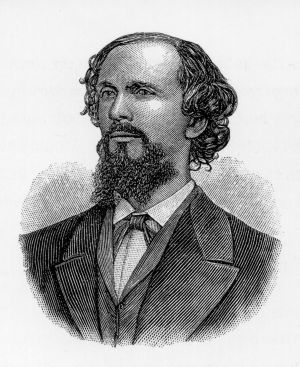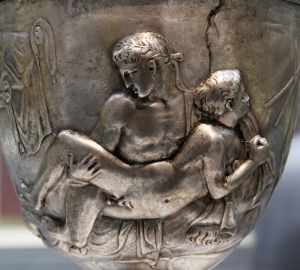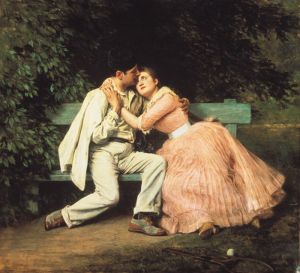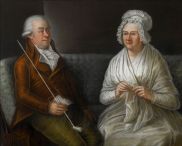Chronophilia

"Chronophilia" is defined as a type of sexual interest or preference for individuals of a particular age.[1]
"Chronophilias" related to minors are nepiophilia (attraction toward infants), pedophilia (prepubescent children), hebephilia (pubescent youth) and ephebophilia (late teens). Chronophilias related to adults are mesophilia and gerontophilia. The only supposedly "typical" form of "chronophilia" is teleiophilia (attraction toward young adults).[2][3]
"Chronophilic" sexual labels, to the extent they are used, do not technically relate to age itself, but to preferences for human sexual maturity stages, connoting features such as body type, muscle development, and secondary sexual characteristics.[4]
Each "chronophilia" is associated with a stage of the Tanner scale of human sexual development, which ranges from stages one to five. Hebephilia, however, corresponds to both stages 2 and 3. All "chronophilias" related to adults correspond to stage 5 of the scale.[4]
Etymology
The term chronophilia (chrono (time) + philia (love)) was coined by psychologist and sexologist John Money to describe a form of "paraphilia" in which an individual experiences sexual attraction limited to individuals of particular age ranges.[5][6]
An arguable historical precursor was Krafft-Ebing's concept of "age fetishism".[7]
Background

Most inclinations described as "chronophilias" are scarcely researched, especially mesophilia and gerontophilia. The existing body of research on the topic is also mainly focused on men. Chronophilias related to sexual attractions to minors (such as pedophilia and hebephilia), however, have a significantly bigger body of modern scientific research compared to the others.[2]
Age-based sexual attractions have been a topic of scientific study for over 150 years, Ulrichs arguably being the first theorist of the field. However, after the mid 1980's there was a cultural and global medicalization of the topic, as well as an intimidation of scholarly inquiries regarding this subject that escaped the field of forensics.[8]
Much of the scientific knowledge of non-teleiophilic "chronophilias" in fact derives from forensic and correctional samples. And non-teleiophilic, criminal offenders are most certainly not representative of the whole population of non-teleiophilic people.[1]
Classification
Each "chonophilia" is related to a stage of the Tanner scale, which is a model that describes the evolution of visible primary and secondary sexual characteristics of human beings from childhood to adulthood. Though physical features are important for eliciting "chronophilic" sexual arousal, psychological features may also play a role in it. Pedophile males, for example, have reported "innocence" and "playfulness" as part of what they find attractive in children.[4]
There is presently no evidence that age preferences among men vary as they themselves age, although some surveys of mature women suggest that the average age of their preferred long-term partner increases with theirs. "Chronophilias" may begin to manifest in the ages associated with menarche and puberty, as is the case for pedophilia and possibly other chronophilias.[4]
It is also said to be possible for human beings to have more than one "chronophilia".[4][9] People who are pedophiles and hebephiles at the same time may be called pedohebephiles.[10]
The term minor-attraction has been used as an umbrella term to classify chronophilias related to minors. Under this terminology, a person who is attracted to minors would be called a minor-attracted person (MAP).[11][12] The usage of this term in scientific articles started growing after 2017.[13] It is controversial among academics whether ephebophiles should be considered minor-attracted.[12][11]
Similarly to other sexual groups, people who are attracted to minors often become aware of their sexual preference during adolescence.[14]
Nepiophilia
Nepiophilia (sometimes called infantophilia) is a form of sexual preference for infants up to the age of 2. This age range corresponds to the Tanner stage 1.[4]
Very little is known about this chronophilia. It, along with gerontophilia, is expected to be one of the rarest chronophilias that exist.[4]
Pedophilia

Pedophilia is a chronophilia whose objects of attraction are prepubescent minors from the ages of 3 to 10. This age range also corresponds to Tanner stage 1.[4]
Pedophilia is the best-researched chronophilia. It has been estimated that the prevalence of pedophilia among the general male population was up to 5%. Pedophilia is more common among men than women, which is the case with most paraphilias (except for masochism and objectophilia, among others).[4]
According to the fifth edition of the Diagnostic and Statistical Manual of Mental Disorders (DSM-5), pedophilia is a paraphilia in which a person has intense sexual urges towards children, and experiences recurrent sexual urges towards and fantasies about children. Pedophilic disorder is further defined as psychological disorder in which a person meets the criteria for pedophilia above, and also either acts upon those urges, or else experiences distress or interpersonal difficulty as a consequence.[15][16]
Hebephilia

Hebephilia is a form of sexual attraction toward pubescent persons, from the ages ot 11 to 14. This age range corresponds to tanner stages 2 and 3.[4]
The term hebephilia was introduced by Bernard Glueck in 1955.[17] It has also been attributed to psychiatrist Paul K. Benedict.[8]
Despite being socially sanctioned in many modern Western societies, hebephilia is not an uncommon form of age-based sexual preference.[4] Hebephilia has not been included as a diagnostic category in the DSM 5.[18]
Ephebophilia
Template:See also Ephebophilia is a pattern of sexual attraction toward post-pubescent youths,[19] from the age of 15 to 17.[4] This age range corresponds to Tanner stage 4.[4]
Ephebophilia is generally considered a normophilia.[20]
Teleiophilia

Teleiophilia (from Greek téleios, "full grown") is a sexual preference for younger adults (20s and 30s).[21] The term was coined by Ray Blanchard in 2000 and has seen less public adoption than some newer terms.[22]
Most human beings are teleiophilic. This chronophilia, like all chronophilias related to adults, is associated to Tanner stage 5.[4]
Mesophilia
Mesophilia (derived from the Greek "mesos", "intermediate") is a sexual preference for middle-aged adults (40s and 50s). The term was coined by Michael Seto in 2016.[23]
Gerontophilia

Gerontophilia is a sexual preference for the elderly (60s and older).[24]
Nonexclusive age interests
Some individuals can be classified as having more than one chronophilia. And the concept of nonexclusivity can also cover nonadjacent age categories as well. Some men, for example, are equally attracted to both children and adults, just like other men are attracted to males and females.[4]
In a research from the Dunkelfeld Project, 39 out of 215 pedophilic individuals and 59% of hebephilic participants identified themselves as nonexclusive.[4]
A research from 2016 found that pedohebephilic women tend to be more nonexclusive than men.[25]
According to a research from the Prevention Project Dunkelfeld, possible chronophilic overlaps include the following:[9]
- pedo-hebephilia: pedophilia + hebephilia;
- pedo-teleiophilia: pedophilia + teleiophilia;
- hebe-teleiophilia: hebephilia + teleiophilia;
- pedo-hebe-teleiophilia: pedophilia + hebephilia + teleiophilia;
Among women
It is widely believed among academics that fewer women than men have non-teleiophilic preferences.[26][4] The overwhelming preponderance of men among people sexually attracted to minors is consistent with the general tendency of men being paraphiles.[25]
In a survey conducted to 1,300 participants who had some form of attraction toward minors, only 5% of the respondents identified as female.[25] It has also been reported that women who had some sort of minor-attraction were more likely to have adult-oriented sexual behaviors, which is consistent with the broader sexuality literature that women are more sexually fluid than men.[27]
Female minor-attracted women have reported feeling further isolated and excluded than men due to their gender. In an interview for a scientific study on women who are attracted to minors, some participants reported feeling as "a minority within a minority".[27]
In popular culture
The prevalence of mesophilia in society is hinted at by the relative popularity of the slang MILF (which stands for "mom I would like to fuck"), as well as the acronym DILF. Results from an online survey about paraphilic sexual interests suggest that 34% of women and 48% of men have reported sexual fantasies about older partners.[4]
The term pedophile is understood differently in academic and popular languages. While academics use this word to refer to people who are sexually attracted to prepubescent children, popular culture often uses the term to refer to anyone who carries out a sexual act with an adolescent. In popular criminology, the word pedophile is used as a generic term to describe a broad array of sexual relationships involving minors.[28]
Cinematic depictions of pedophiles, in the popular definition, include Hans Becker from M (1931 movie) and the protagonist of The Mark (1961), both of whom are portrayed as criminals.[28]
Society and stigma

Teleiophilia is the most common chronophilia among human beings.[4] Ephebophilia is generally considered a normophilia.[20]
Chronophilias related to minors are associated with a higher social stigma. Research has shown that though some minor-attracted persons may receive positive social support after disclosing their attractions, others may encounter negative reactions such as threats, loss of friendships and increased levels of stress, even if they had commited no criminal offenses. In two joint studies about the topic, 38% and 49% of participants stated that minor-attracted persons who had not commited a crime should be nonetheless incarcerated, and 14 and 27% belived they would be better off dead.[14]
Individuals who are attracted to minors might also suffer from internalized stigma against their own sexual impulses.[29]
Though there are no restrictions on consensual depictions of adults in pornographic media, erotic pornographic material involving minors are illegal.[4]
See also
Wikipedia
References
- ↑ 1.0 1.1 Mokros, A. (Jan, 2017). The Chronophilia Conundrum: Continuum or Epiphenomenon? Archives of Sexual Behavior, volume 46, issue 1, pages 43–45, pmid 27778133, doi 10.1007/s10508-016-0882-4, s2cid 254250686
- ↑ 2.0 2.1 Seto, M. What are chronophilias? The Conversation
- ↑ Singal, J. (2016). Being Into Middle-Aged People Is Probably a Sexual Orientation The Cut
- ↑ 4.00 4.01 4.02 4.03 4.04 4.05 4.06 4.07 4.08 4.09 4.10 4.11 4.12 4.13 4.14 4.15 4.16 4.17 4.18 4.19 Seto, MC. (January 2017). The Puzzle of Male Chronophilias Archives of Sexual Behavior, volume 46, issue 1, pages 3–22, pmid 27549306, doi 10.1007/s10508-016-0799-y, s2cid 254256051
- ↑ Money, J. (1986). Lovemaps: clinical concepts of sexual/erotic health and pathology, paraphilia, and gender transposition of childhood, adolescence, and maturity. isbn 978-0-8290-1589-8, pages 70, 260
- ↑ Money, J. (1990). Gay, Straight, and In-Between: The Sexology of Erotic Orientation. isbn 978-0-19-505407-1, pages 137, 183
- ↑ Janssen, DF. (2015). 'Chronophilia': Entries of Erotic Age Preference into Descriptive Psychopathology. Medical History, volume 59, issue 4, pages 575–598, pmid 26352305, pmc 4595948, doi 10.1017/mdh.2015.47
- ↑ 8.0 8.1 8.2 , {{{first}}} ({{{year}}}). ""Chronophilia": Appreciating 150 Years of Puzzle-Solving," Archives of Sexual Behavior, 46, 35–38.
- ↑ 9.0 9.1 Beier, {{{first}}} ({{{year}}}). "Hebephilia as a sexual disorder," Fortschritte der Neurologie-Psychiatrie, 83, e1–9.
- ↑ Jahnke, Sara et al (2023). Pedohebephilia and Perceived Non-coercive Childhood Sexual Experiences: Two Non-matched Case-Control Studies. Sexual Abuse, volume 35, issue 3, pages 340 374, doi 10.1177/10790632221098341, issn 1079-0632, pmc 10041574, pmid 35549946
- ↑ 11.0 11.1 Lievesley R, Lapworth R. (February 2022). "We Do Exist": The Experiences of Women Living with a Sexual Interest in Minors. Archives of Sexual Behavior, volume 51, issue 2, pages 879–896, doi 10.1007/s10508-021-02160-z, pmc 8888496, pmid 34791582
- ↑ 12.0 12.1 Lievesley et al (2022). Primary Health Professionals' Beliefs, Experiences, and Willingness to Treat Minor-Attracted Persons. Archives of Sexual Behavior, volume 51, issue 2, pages 923–943, doi 10.1007/s10508-021-02271-7, issn 1573-2800, pmc 8793822, pmid 35084616
- ↑ Jahnke, {{{first}}} ({{{year}}}). "Pedophile, Child Lover, or Minor-Attracted Person? Attitudes Toward Labels Among People Who are Sexually Attracted to Children," Archives of Sexual Behavior, 51, 4125–4139.
- ↑ 14.0 14.1 Walker, {{{first}}} ({{{year}}}). "Minor Attraction: A Queer Criminological Issue," Critical Criminology, 25, 37–53.
- ↑ American Psychiatric Association, Highlights of Changes from DSM-IV-TR to DSM-5 Template:Webarchive Paraphilic disorders (page 18)
- ↑ American Psychiatric Association, {{{first}}} (June 2000). Diagnostic and Statistical Manual of Mental Disorders DSM-IV TR (Text Revision), 943. American Psychiatric Publishing, Inc..
- ↑ Template:Cite report
- ↑ Beier, {{{first}}} ({{{year}}}). "Hebephilia as a sexual disorder," Fortschritte der Neurologie-Psychiatrie, 83, e1–9.
- ↑ Blanchard, R. Blanchard, R., Lykins, A. D., Wherrett, D., Kuban, M. E., Cantor, J. M., Blak, T., Dickey, R., & Klassen, P. E. (2008). Pedophilia, hebephilia, and the DSM–V. Archives of Sexual Behavior. Template:Doi.
- ↑ 20.0 20.1 Hames, {{{first}}} ({{{year}}}). "Anthropological Data Regarding the Adaptiveness of Hebephilia," Archives of Sexual Behavior, 41, 745–747.
- ↑ , {{{first}}} ({{{year}}}). "Fraternal birth order and sexual orientation in pedophiles," Archives of Sexual Behavior, 29, 463–478.
- ↑ , {{{first}}} ({{{year}}}). "The strength of sexual arousal as a function of the age of the sex offender: comparisons among pedophiles, hebephiles, and teleiophiles," Sexual Abuse, 17, 441–456.
- ↑ , {{{first}}} ({{{year}}}). "The Puzzle of Male Chronophilias," Archives of Sexual Behavior, 46, 3–22.
- ↑ , {{{first}}} ({{{year}}}). "Gerontophilia--a case report," Medicine, Science, and the Law, 31, 110–114.
- ↑ 25.0 25.1 25.2 , {{{first}}} ({{{year}}}). "Orienting Basic Research on Chronophilias," Archives of Sexual Behavior, 46, 23–26.
- ↑ , {{{first}}} ({{{year}}}). "What can the eyes tell us about atypical sexual preferences as a function of sex and age? Linking eye movements with child-related chronophilias.," Forensic Sciences Research, {{{volume}}}, owad009.
- ↑ 27.0 27.1 , {{{first}}} ({{{year}}}). ""We Do Exist": The Experiences of Women Living with a Sexual Interest in Minors," Archives of Sexual Behavior, 51, 879–896.
- ↑ 28.0 28.1 Kohm, {{{first}}} ({{{year}}}). "Pedophile crime films as popular criminology: A problem of justice?," Theoretical Criminology, 15, 195–215.
- ↑ Lievesley, {{{first}}} ({{{year}}}). "The Internalization of Social Stigma Among Minor-Attracted Persons: Implications for Treatment," Archives of Sexual Behavior, 49, 1291–1304.